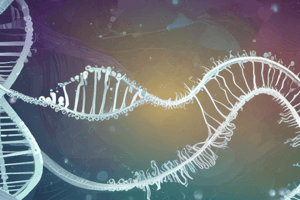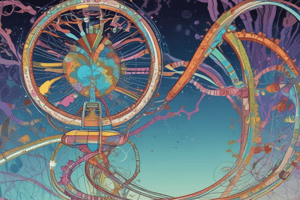Podcast
Questions and Answers
What term describes stable changes in gene expression that are passed from cell to cell without altering the DNA sequence?
What term describes stable changes in gene expression that are passed from cell to cell without altering the DNA sequence?
- Environmental mutation
- Gene regulation
- Genomic imprinting
- Epigenetic regulation (correct)
Which of the following is NOT a rule of Mendelian inheritance?
Which of the following is NOT a rule of Mendelian inheritance?
- Genes are passed unaltered from cell to cell
- Crosses with more than two genes obey independent assortment
- The genes obey Mendel's law of segregation
- All genes are independent of each other (correct)
What does the term 'epi-' in epigenetics signify?
What does the term 'epi-' in epigenetics signify?
- Altered
- Beyond
- Under
- Over (correct)
What type of inheritance involves genetic material that is located outside of the nucleus?
What type of inheritance involves genetic material that is located outside of the nucleus?
Which process ensures that muscle cell genes are expressed at high levels during development?
Which process ensures that muscle cell genes are expressed at high levels during development?
Which of the following is an example of how environmental signals can influence gene expression?
Which of the following is an example of how environmental signals can influence gene expression?
What is the relationship between epigenetics and phenotypic variation in human cells?
What is the relationship between epigenetics and phenotypic variation in human cells?
How do genes on the same chromosome typically behave in a genetic cross?
How do genes on the same chromosome typically behave in a genetic cross?
What is the result of vernalization in flowering plants?
What is the result of vernalization in flowering plants?
Which of the following is true regarding X inactivation in female mammals?
Which of the following is true regarding X inactivation in female mammals?
How is epigenetic inheritance described?
How is epigenetic inheritance described?
What defines a mosaic individual in the context of Calico cats?
What defines a mosaic individual in the context of Calico cats?
What is the primary cause of mitochondrial diseases in humans?
What is the primary cause of mitochondrial diseases in humans?
How do linked genes behave during meiotic recombination?
How do linked genes behave during meiotic recombination?
What is a Barr body?
What is a Barr body?
Which mechanism ensures equal expression levels of X-linked genes in males and females?
Which mechanism ensures equal expression levels of X-linked genes in males and females?
In the case of Leber’s hereditary optic neuropathy (LHON), what is a significant feature of the inheritance pattern?
In the case of Leber’s hereditary optic neuropathy (LHON), what is a significant feature of the inheritance pattern?
What is the purpose of genetic mapping in the context of recombination frequencies?
What is the purpose of genetic mapping in the context of recombination frequencies?
What does a recombination frequency of 1% correspond to in genetic mapping?
What does a recombination frequency of 1% correspond to in genetic mapping?
What can be concluded from the high frequency of nonrecombinant phenotypes in a dihybrid cross involving linked genes?
What can be concluded from the high frequency of nonrecombinant phenotypes in a dihybrid cross involving linked genes?
Which of the following describes extranuclear inheritance?
Which of the following describes extranuclear inheritance?
Flashcards
Epigenetics
Epigenetics
Stable changes in gene expression that are passed from cell to cell, and are reversible, but without changing the DNA sequence.
Gene Expression
Gene Expression
The process of converting DNA instructions into functional molecules, typically proteins.
Genomic Imprinting
Genomic Imprinting
A type of epigenetic mechanism where the expression of a gene depends on whether it was inherited from the mother or father.
X-Chromosome Inactivation
X-Chromosome Inactivation
Signup and view all the flashcards
Environmental Agents
Environmental Agents
Signup and view all the flashcards
Extranuclear Inheritance
Extranuclear Inheritance
Signup and view all the flashcards
Linkage
Linkage
Signup and view all the flashcards
Mendelian Inheritance
Mendelian Inheritance
Signup and view all the flashcards
Epigenetic Silencing
Epigenetic Silencing
Signup and view all the flashcards
Vernalization
Vernalization
Signup and view all the flashcards
Epigenetic Inheritance
Epigenetic Inheritance
Signup and view all the flashcards
What is a Barr body?
What is a Barr body?
Signup and view all the flashcards
Calico Cat
Calico Cat
Signup and view all the flashcards
Dosage Compensation
Dosage Compensation
Signup and view all the flashcards
Organelle Genome
Organelle Genome
Signup and view all the flashcards
Leaf Color Example
Leaf Color Example
Signup and view all the flashcards
Mitochondrial Disease
Mitochondrial Disease
Signup and view all the flashcards
LHON
LHON
Signup and view all the flashcards
Gene Linkage
Gene Linkage
Signup and view all the flashcards
Linkage Group
Linkage Group
Signup and view all the flashcards
Recombinants
Recombinants
Signup and view all the flashcards
Genetic Mapping
Genetic Mapping
Signup and view all the flashcards
Map Unit
Map Unit
Signup and view all the flashcards
Study Notes
Chapter 18: Epigenetics, Linkage, and Extranuclear Inheritance
-
Mendelian inheritance follows three rules:
- Genes are passed unchanged from cell to cell and across generations.
- Genes obey Mendel's law of segregation.
- Crosses with more than two genes follow Mendel's law of independent assortment.
-
This chapter examines deviations from Mendelian rules due to:
- Epigenetics
- Genetic material outside the nucleus
- Genes on the same chromosome
Epigenetics
- Gene expression: DNA → RNA → Protein
- DNA mutations can affect the phenotype by altering the RNA or protein produced.
- Changes in gene expression can also affect the phenotype by changing the amount of RNA and protein produced.
- Transient changes in gene expression due to environmental signals are considered gene regulation.
- Epigenetic gene regulation involves stable changes in gene expression that are passed between cells but do not alter DNA sequence.
Example: Human Cell Types
- All human cells contain the same DNA but exhibit different phenotypes.
- For example, muscle cells express high levels of actin and myosin for contraction.
- Epigenetic changes during development turn specific genes on or off, distinguishing cell types.
Example: Vernalization
- Some flowering plants require cold temperatures (vernalization) to flower.
- During winter, cold temperatures cause epigenetic silencing of the FLC gene, preventing flowering until warmer weather.
- Epigenetic changes are reversed after flowering to promote flowering in the next season.
Epigenetic Inheritance
- Some epigenetic changes can be inherited from parent to offspring through sperm or egg cells.
- Most epigenetic changes are not inherited, like those induced by environmental factors (e.g., cigarette smoke).
X Inactivation
- In female mammals, one X chromosome is randomly inactivated in all somatic cells during early embryonic development.
- The inactivated X chromosome is condensed and visible as a Barr body.
- This process ensures equal levels of expression for X-linked genes in males and females.
Calico Cats
- Calico cats are heterozygous females (XXBXO) with fur color determined by genes on the X chromosome.
- Inactivation of one X chromosome leads to a mosaic pattern of orange and black fur color in calico cats.
X Inactivation: Dosage Compensation
- X inactivation is a dosage compensation mechanism.
- Mammalian cells have molecular mechanisms for determining X chromosome number and inactivating all but one.
Extranuclear Inheritance
- This involves transmission of genes located outside the cell nucleus.
- Mitochondria and chloroplasts contain their own DNA (organelle genomes) and are typically inherited maternally.
- Mutations in organelle genomes can lead to various rare diseases.
Example: Leaf Color
- Mutations in the chloroplast genome can affect chlorophyll synthesis and leaf color (e.g., variegated patterns).
- The inheritance pattern of leaf pigmentation in some plants doesn't follow Mendelian segregation; inheritance is solely maternal.
Mitochondrial Genomes
- The mitochondrial genome contains genes for translation and oxidative phosphorylation (e.g., 37 genes in many mammals).
- Mutations in mitochondrial genes can cause rare, maternally inherited diseases, primarily affecting organs requiring high ATP.
- A male, if affected by a mitochondrial disease, can't pass it to his offspring.
Example: Leber's Hereditary Optic Neuropathy (LHON)
- LHON is a maternally inherited form of vision loss caused by mutations in mitochondrial genes.
- This reduces ATP production in optic nerve cells, leading to cell death.
- Males inherit the disease from their mothers but can't pass it to their offspring.
- Symptomology depends on the extent of the mutation.
Gene Linkage
- When genes are located close together on the same chromosome, they tend to be inherited together as a unit; this is called linkage.
- Linked genes are part of linkage groups, which do not follow the law of independent assortment.
Bateson & Punnett's Crosses
- This 1911 study provided early evidence of gene linkage in sweet peas.
- They observed that some phenotypes occurred more frequently than expected by independent assortment.
Morgan's Fruit Flies
- Morgan's work with fruit flies demonstrated gene linkage and the concept of crossover configurations during meiosis.
- Crossing over leads to new combinations of alleles in offspring.
Linkage Mapping
- Recombination frequencies are used to map genes along chromosomes.
- The closer the genes are located, the lower the recombination frequency.
- Genetic maps provide the linear arrangement and relative distances of genes.
Example of Genetic Linkage Map
- Maps were developed showing the locations and distances of genes (e.g., Drosophila traits).
- Distance in map units corresponds with recombination frequencies in test crosses, where 1% recombination equals 1 map unit.
Studying That Suits You
Use AI to generate personalized quizzes and flashcards to suit your learning preferences.
Related Documents
Description
Explore the complexities of genetics in Chapter 18, which covers epigenetics, linkage, and extranuclear inheritance. Understand how gene expression and environmental factors can lead to variations that deviate from Mendelian inheritance. This chapter delves into how genetic material interacts beyond the nucleus and the implications for phenotype expression.




